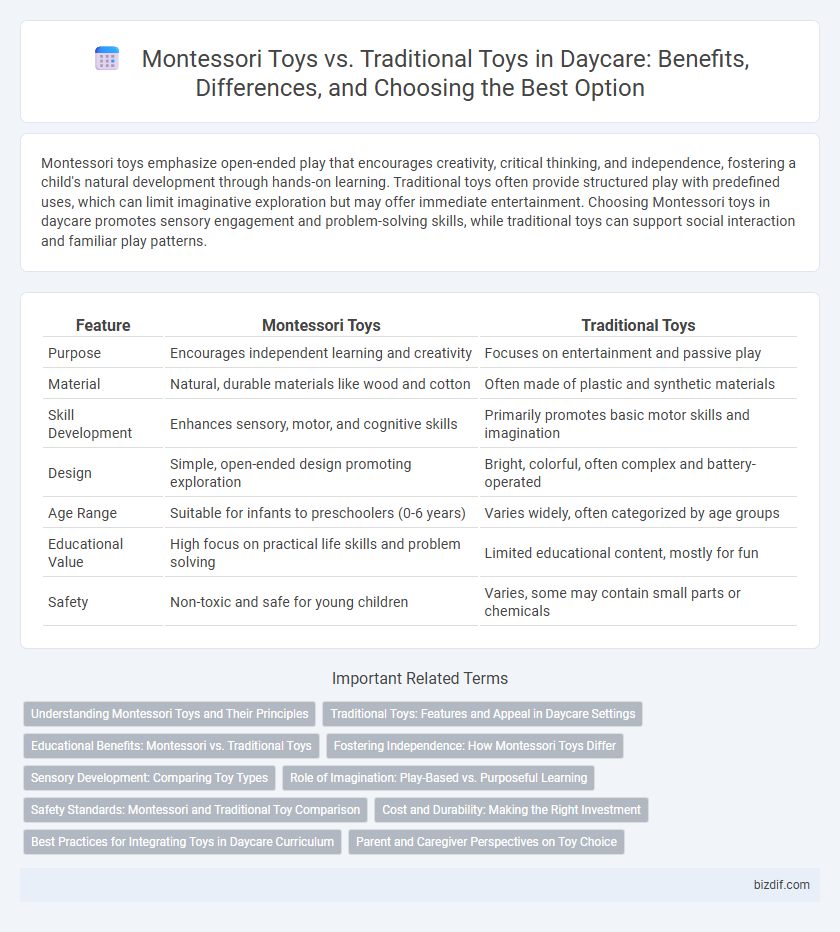Montessori toys emphasize open-ended play that encourages creativity, critical thinking, and independence, fostering a child's natural development through hands-on learning. Traditional toys often provide structured play with predefined uses, which can limit imaginative exploration but may offer immediate entertainment. Choosing Montessori toys in daycare promotes sensory engagement and problem-solving skills, while traditional toys can support social interaction and familiar play patterns.
Table of Comparison
| Feature | Montessori Toys | Traditional Toys |
|---|---|---|
| Purpose | Encourages independent learning and creativity | Focuses on entertainment and passive play |
| Material | Natural, durable materials like wood and cotton | Often made of plastic and synthetic materials |
| Skill Development | Enhances sensory, motor, and cognitive skills | Primarily promotes basic motor skills and imagination |
| Design | Simple, open-ended design promoting exploration | Bright, colorful, often complex and battery-operated |
| Age Range | Suitable for infants to preschoolers (0-6 years) | Varies widely, often categorized by age groups |
| Educational Value | High focus on practical life skills and problem solving | Limited educational content, mostly for fun |
| Safety | Non-toxic and safe for young children | Varies, some may contain small parts or chemicals |
Understanding Montessori Toys and Their Principles
Montessori toys are designed to promote independent learning, sensory exploration, and fine motor skills through natural materials and realistic objects, contrasting with traditional toys that often emphasize entertainment and mass production. These toys encourage hands-on interaction, fostering concentration, creativity, and problem-solving in young children by aligning with the Montessori principles of child-led discovery and practical life skills. Emphasizing simplicity, order, and purposeful activity, Montessori toys support holistic development and intrinsic motivation, making them a valuable addition to early childhood environments like daycares.
Traditional Toys: Features and Appeal in Daycare Settings
Traditional toys in daycare settings feature durable materials and simple designs that encourage imaginative play and social interaction among children. Their familiarity and ease of use make them accessible for various developmental stages, promoting fine motor skills and cooperative learning. These toys often provide versatile opportunities for creative exploration, supporting foundational cognitive and emotional growth.
Educational Benefits: Montessori vs. Traditional Toys
Montessori toys promote hands-on learning and sensory development through natural materials and open-ended play, fostering critical thinking and fine motor skills. Traditional toys often emphasize entertainment and predefined functions, which can limit creativity and problem-solving opportunities. Educational benefits of Montessori toys include enhanced concentration, independence, and cognitive growth compared to the more structured, passive engagement encouraged by traditional toys.
Fostering Independence: How Montessori Toys Differ
Montessori toys prioritize fostering independence by encouraging self-directed play and problem-solving, promoting fine motor skills and cognitive development through hands-on, open-ended activities. Unlike traditional toys which often emphasize passive entertainment or guided instruction, Montessori materials are designed to be intuitive and accessible, allowing children to explore and learn at their own pace. This approach supports the development of confidence, concentration, and autonomy crucial for early childhood growth in daycare settings.
Sensory Development: Comparing Toy Types
Montessori toys prioritize natural materials and open-ended play, fostering sensory development by engaging children's tactile, visual, and auditory senses more effectively than traditional plastic toys. Traditional toys often emphasize structured play with limited sensory stimuli, potentially restricting opportunities for children to explore textures, shapes, and sounds in diverse ways. Sensory-rich Montessori toys, such as wooden blocks, textured puzzles, and sorting games, support cognitive growth and fine motor skills by encouraging interactive, hands-on learning experiences in early childhood environments.
Role of Imagination: Play-Based vs. Purposeful Learning
Montessori toys foster purposeful learning by encouraging children to engage in hands-on, sensory-rich activities that develop problem-solving skills and independent thinking. Traditional toys often emphasize play-based imagination, allowing children to create stories and scenarios that nurture creativity and social interaction. Combining both learning approaches in daycare can enhance cognitive development by balancing structured skill-building with free imaginative play.
Safety Standards: Montessori and Traditional Toy Comparison
Montessori toys are designed with non-toxic, natural materials and smooth edges that meet strict safety standards to minimize choking hazards and toxic exposure. Traditional toys vary widely in safety compliance, often including plastics and small detachable parts that can pose risks for young children. Rigorous testing and certification programs for Montessori toys ensure consistent adherence to safety regulations, making them a preferred choice for daycare environments focused on child well-being.
Cost and Durability: Making the Right Investment
Montessori toys typically involve higher upfront costs due to their natural materials and thoughtful design, but they often offer superior durability compared to traditional plastic toys that may wear out quickly. Investing in Montessori toys supports long-term use and educational value, reducing frequent replacement expenses. Traditional toys might be cheaper initially but can lead to higher costs over time due to lower durability and less developmental benefit.
Best Practices for Integrating Toys in Daycare Curriculum
Montessori toys emphasize hands-on, sensory-rich learning experiences that foster independence and cognitive development, aligning with child-centered pedagogy in daycare settings. Integrating these toys involves selecting materials that promote open-ended exploration while ensuring they are age-appropriate and safe, thus supporting fine motor skills and creativity. Traditional toys can complement this approach by encouraging social interaction and imaginative play when incorporated thoughtfully into a balanced, developmentally appropriate curriculum.
Parent and Caregiver Perspectives on Toy Choice
Parents and caregivers often prefer Montessori toys for their emphasis on sensory development and hands-on learning, which align with early childhood educational goals. Traditional toys may be favored for their familiarity and entertainment value, yet Montessori options support cognitive growth and independent play. The decision typically reflects a balance between fostering developmental skills through purposeful design and providing engaging, age-appropriate activities.
Montessori toys vs Traditional toys Infographic

 bizdif.com
bizdif.com